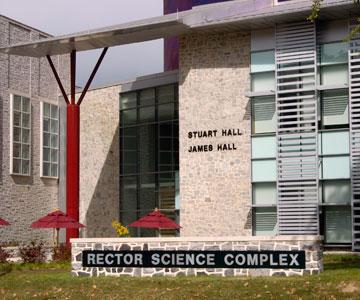College's Science Complex Receives LEED Gold Rating

The latest additions to Dickinson College’s new Rector Science Complex, Stuart and James halls, have achieved LEED Gold from the U.S. Green Building Council’s Leadership in Energy and Environmental Design (LEED) program. Stuart and James halls reflect Dickinson’s nationally recognized science programs as well as its commitment to the environment and sustainability in its curriculum and facilities. Designed by Zimmer Gunsul Frasca Architects LLP of Washington D.C., Stuart and James halls are among only a handful of science centers at colleges nationally to receive gold certification.
“The Rector Science Complex puts Dickinson at the forefront of teaching undergraduate science research,” said President William G. Durden. “This 21st century science complex permanently places the college among the very best liberal-arts colleges academically in the country—where our founder, Dr. Benjamin Rush, aspired for us to be. Stuart and James halls now join Dickinson’s Center for Sustainable Living, which also is LEED Gold certified, as testament to our mission of educating students to adopt and innovate ways to conserve and preserve as part of the global community. Educating students is where we can best contribute to a sustainable future.”
Completed last spring, Stuart and James halls highlight Dickinson’s environmental stewardship and serve as places of scientific exploration and learning in an environment that is artful and sustainable. Featuring 90,000 square feet of state-of-the art laboratories, classrooms and research facilities, the halls house the departments of biology, chemistry, psychology and interdisciplinary programs in biochemistry & molecular biology and neuroscience. Courses in the emerging fields of bioinformatics—a blend of biology and computer science—and nanotechnology—the applied study of particles the size of molecules—also are taught there. The new science complex was designed to afford learning opportunities outside of the classrooms and labs, and even outside of the building’s walls on the site of the new complex. For instance, aquatic resource monitoring and botanical studies are just two possibilities that the site offers students and faculty. The previously developed site has been restored with native, natural plantings that require no mechanical irrigation. Site storm water is mitigated by a retention pond/bioswale (removes silt and pollution from surface runoff water) to reduce the load on the municipal storm water system and provide cleaner storm water. In fact, during design, Stuart Hall was shifted westward to preserve a large linden tree and a specimen horse chestnut tree on site.
In addition to the building massing and orientation, glazing and sunscreen strategies allow for comfortable and well daylit indoor teaching environments. Nearly all of the spaces in the new halls offer direct outdoor views and more than half of the open space is punctuated by natural light. Both halls feature social commons, interactive spaces and several outdoor areas. The college has been historically one of the lowest energy users per square foot in the country and currently purchases 50% of its campus electricity needs from wind-generated power. Enthalpy heat wheel recovery mechanical systems (four) and extensive commissioning guarantees that the building systems and energy use performs as intended. A 30-percent reduction in water use is achieved through efficient fixtures and significant energy savings are generated from the high-efficiency windows, exterior sun shading, interior light harvesting, occupancy sensors and interior sunshades. “In recent years there has been a revolution in the teaching of science,” said Provost and Dean Neil Weissman. “That revolution has included three key dimensions—a new, more active approach to teaching science through more intensive workshops, labs and field study; a heightened emphasis on student/faculty research; and interdisciplinary approaches to science as reflected, for example, in biochemistry, neuroscience and bioinformatics. The Rector Science Complex enabled Dickinson to capture all three.”
Cindy Samet, associate professor of chemistry said of the Rector Science Complex, “Scientists all over—at government labs, universities, colleges, medical research centers—work alone and must overcome barriers to collaborate and share their energy. Most scientists will never work in a facility like this one. I’ve never seen anything like it. Study spaces that place students in close proximity to fellow students and professors engaged in teaching and research, where interaction spaces and spacious laboratories allow teaching and research to meander and mingle. A connectedness renders our individual classrooms and laboratories much larger than the sum of the parts. It is a people building.”
The Rector Science Complex, which includes Tome Hall, is named for the late Dr. Robert Rector and his late wife Dorothy, who donated more than $17 million to enable Dickinson to advance its commitment to science in undergraduate education.
LEED is a third-party certification program and the nationally accepted benchmark for the design, construction and operation of high-performance green buildings. LEED promotes a whole-building approach to sustainability by recognizing performance in five key areas of human and environmental health: sustainable site development, water savings, energy efficiency, materials selection and indoor environmental quality. The four levels of certification include in ascending order: certified, silver, gold and platinum. Last fall, Dickinson was one of 15 colleges and universities in the United States and Canada to achieve designation as “Overall College Sustainability Leader” in the 2009 edition of the College Sustainability Report Card. Each of the 15 schools earned the highest overall grade of “A-.”
The other 14 schools in the top category are Middlebury College, Oberlin College, Carleton College, Dartmouth College, Brown University, University of New Hampshire, University of British Columbia, Columbia University, Harvard University, University of Colorado, University of Pennsylvania, University of Vermont, University of Washington and Stanford University.
Published June 6, 2013